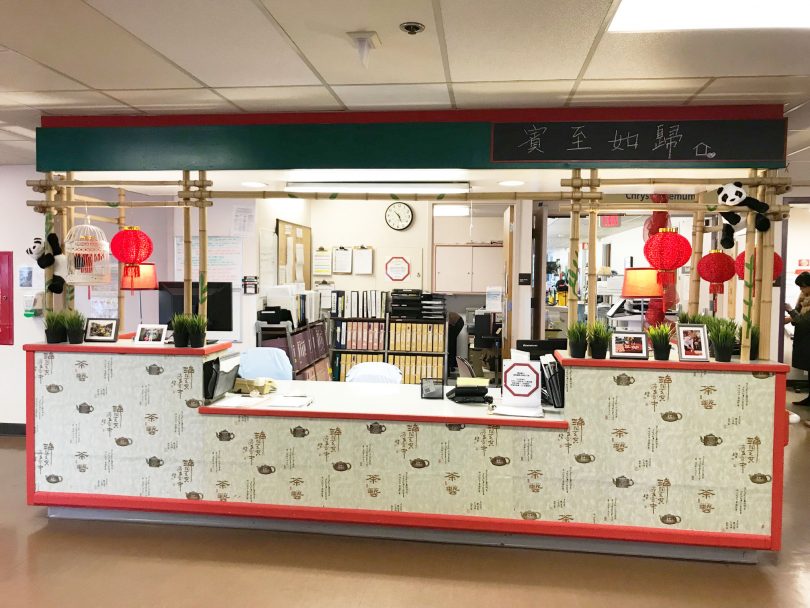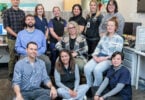Stepping into the main dining room at Mount Saint Joseph’s Residence, one hears laughter from a corner where residents sit, amused by virtual (robotic) pets. The clicking of tiles is heard from two games of mahjong being played on opposite ends of the room. The nurses’ station has been transformed into a Chinese tea house (that actually serves tea!). Meanwhile, other residents sit around a once-bare table, now covered with a patterned tablecloth, reading newspapers from a large pile clustered in the centre. The gentle din of conversation between new friends carries on as people pull together chairs for an afternoon chat.

Small changes are having a positive impact on the residents, families and staff at MSJ, the latest of Providence Health Care’s five care homes to undergo the cultural transformation called Megamorphosis. The leadership team of Sonia Hardern, Heather Mak, Robena Sirett and Jo-Ann Tait works with each care home’s team to transform institutions (based on hospital models) into care homes that actually feel like home, instead of living in a hospital setting. The initiative is guided by three themes that evolved from years of ideas and insight gathered from residents, staff and families:
- Residents direct each moment
- Emotional connections matter most
- Home is not just a place, it’s a feeling
The recent two-week intensive transformation at MSJ involved testing out a variety of ways to increase the engagement level of every resident in the Plum Neighbourhood and thus create a vibrant community. In addition to new décor, items have been thoughtfully and carefully brought into the care home based on the process used with residents, staff and families to understand what brings them peace, comfort and joy. There were over 30 intentional ideas tested and trialed using the quality improvement process created by the Megamorphosis model.

Below: Soft balls of yarn and a popular robotic kitty provide positive sensory experiences for many residents.
“Part of the beauty of Megamorphosis is trying to honour the uniqueness that each resident brings and creating opportunities to help them find peace, comfort and joy every single day – many times a day,” says Sonia Hardern, Performance Improvement Consultant at PHC.
A 104-year-old woman, who had previously spent many hours sitting quietly in her wheelchair, began talking to a robotic cat that mimics the sounds and movements of a real feline the moment a staff person placed it on her lap.
“She lit up. She spent the whole day taking care of it and petting it,” Hardern says.
Positive responses like this have caused staff to start seeing residents they care for in a different light as they react to things they hadn’t experienced in the care home prior to Megamorphosis.

As a retired woodworker, resident Kong Sang was happy to help spruce up some plain wooden name plates with a bright coat of paint. The new wooden signs now hang outside the bedroom doors, accompanied by fresh photos of the residents that preserve their beauty and elegance.
Just like other PHC sites that have already undergone Megamorphosis, like Youville and Brock Fahrni’s Orange Neighbourhood, MSJ now has a Wish Fulfilling Tree. The wall decal displays photos of each resident along with a list of three things that bring them peace, comfort and joy – things like “family visits,” “going to church,” and “dim sum.” The tree helps staff get to know residents better and serves as a great conversation starter.
Building on the Wish Fulfilling Tree, decal images and graphics are also starting to appear inside the bedrooms, where the residents’ closet doors have been painted in their colour of choice to help establish personalized space and reflect their story.

While it’s hard to miss the visible changes at MSJ, Heather Mak, Clinical Nurse Specialist, emphasizes that Megamorphosis is much more than decorations and fresh paint.
“There’s a lot behind the scenes going on around engaging the residents and making sure that we’re making emotional connections with them. We have supported the staff for two months with intentional group and individual work, supported by trained counsellors/psychologists, in order to prepare them for these two weeks of Megamorphosis,” she says.
Megamorphosis involves residents, family members and staff every step of the way, from brainstorming to implementing change to getting feedback. Volunteer interpreters, as well as the leadership team from Villa Cathay, helped out during the two months of pre-work and during the two-week intense Megamorphosis at MSJ since many residents speak only Mandarin or Cantonese. Using that valuable insight, the ultimate goal is to find ways to engage all residents, no matter their physical capacity or cognitive ability, with the help of staff and family who know them best.
“We have been very intentional in bringing in other people to experience the culture transformation – from UBC Masters (MHLP) students to VCH Leaders and other care home change makers. Megamorphosis is a process that can be adopted in any care home, with the right leadership and a willingness to take a chance and try,” says Robena Sirett, Site Leader Honoria Conway and Clinical Planner.
The initiative is closely tied to the ongoing Residential Redevelopment Project planning, which envisions changing current care homes from an institutionalized, traditional model of care to a social model where first and foremost we create a home and community that people want to live, visit and work in.





